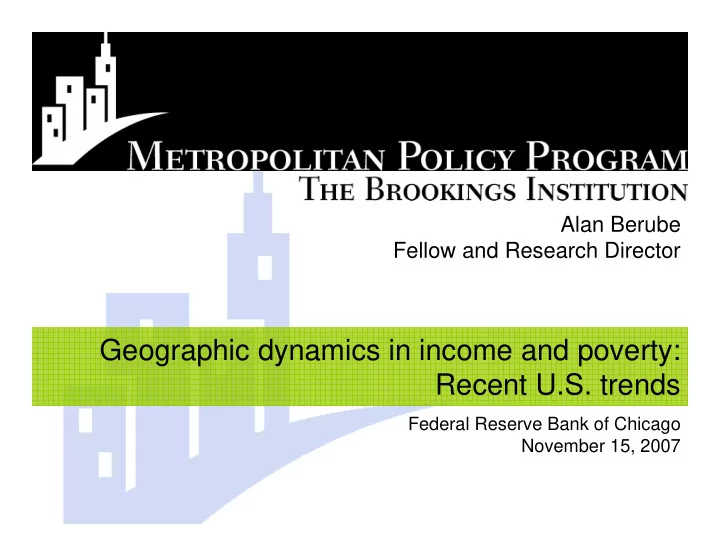

Alan Berube Fellow and Research Director Geographic dynamics in income and poverty: Recent U.S. trends Federal Reserve Bank of Chicago November 15, 2007
Basic storylines on geographic dynamics in income and poverty Recent regional economic growth has been highly uneven Regional poverty rate changes have been similarly uneven Most metro areas have seen incomes polarize Cities remain poorer than suburbs, but suburbs house bulk of poor Many metro areas divide along income lines Concentrated poverty declined in 1990s, but appears to be rising again
Geography can shape opportunity, as well as one’s view of poverty
Why focus on geography? Efforts to help low-wage workers face variable regional economic contexts States, localities, and regions bring different policy structures and capacities to bear on issues affecting low-wage workers Families may contend with micro-barriers based on differential geographic access to jobs, public & private goods Yet more detailed geographic focus limits certain types of information, e.g., longitudinal analyses Migration may also complicate the link between geography & poverty
Regions Recent regional economic growth has been highly uneven— productivity % change in real GDP per job, 100 largest metro areas, 2001-2005 Source: Brookings analysis of BEA data -5.5% to 3.6% -3.7% to 6.0% 6.1% to 9.4% 9.5% to 22.2%
Regions Recent regional economic growth has been highly uneven— employment rate Employment rate change, 100 largest metro areas, 2000 to 2006 Source: Brookings analysis of Census Bureau data -4.8% to -1.5% -1.4% to -0.5% -0.4% to 0.6% 0.7% to 5.7%
Regions Regional poverty rate changes have been similarly uneven Poverty rate changes in 100 largest metro areas, 2000 to 2005 Source: Brookings analysis of Census Bureau data
Regions In areas where poverty increased, it tended to increase more dramatically for children Change in overall poverty rate and child poverty rate, 2000 to 2005, selected metro areas 12 Overall Poverty Child Poverty 10 Poverty rate increase, 2000 to 2005 8 6 4 2 0 El Paso, TX McAllen, TX Greensboro, Lansing, MI Portland, OR Wichita, KS Toledo, OH Grand Rapids, Knoxville, TN Cleveland, OH NC MI Error bars represent 90% confidence interval of the estimate Metro Area Source: Brookings analysis of Census Bureau data
Regions Most metro areas have seen incomes polarize over the long term Metro Area Lower-income Middle-income Upper-income (<80% AMI) (80-150% AMI) (>150% AMI) Change in share New York, NY 3.6 -12.3 8.7 of families by income class, Los Angeles, CA 4.3 -14.9 10.6 top 10 metro Chicago, IL 5.0 -14.2 9.2 areas, 1970-2005 Philadelphia, PA 4.6 -12.5 7.9 Source: Brookings Dallas, TX 4.0 -12.5 8.5 analysis of Census Bureau data Miami, FL 1.7 -8.0 6.3 Houston, TX 4.4 -15.2 10.8 Washington, DC 2.2 -7.7 5.5 Atlanta, GA 2.5 -8.0 5.5 Detroit, MI 5.0 -15.4 10.4 Total (100 metros) 3.8 -11.7 8.0
Cities and suburbs Today, cities continue to have higher poverty rates than suburbs… 20 Poverty rate, 18 18.8 18.1 17.9 cities vs. 16 suburbs, 100 14 largest metro areas, 1990-2005 12 Source: Brookings 10 analysis of Census 9.4 8 Bureau data 8.4 8.5 6 4 2 0 1990 2000 2005 Central cities Suburbs
Cities and suburbs …but suburbs house a majority of the poor in major metro areas Below-poverty population, central cities versus suburbs, 100 largest metros, 1990- 2005 Source: Brookings analysis of Census Bureau data 1990 Poor in cities—53% Poor in suburbs—47%
Cities and suburbs …but suburbs house a majority of the poor in major metro areas Below-poverty population, central cities versus suburbs, 100 largest metros, 1990- 2005 Source: Brookings analysis of Census Bureau data 2000 Poor in cities—50% Poor in suburbs—50%
Cities and suburbs …but suburbs house a majority of the poor in major metro areas Below-poverty population, central cities versus suburbs, 100 largest metros, 1990- 2005 Source: Brookings analysis of Census Bureau data 2005 Poor in cities—47% Poor in suburbs—53%
Neighborhoods Yet many metro areas divide along income lines Neighborhoods by median family income, DC metro area, 2000 Source: Brookings analysis of Census Bureau data Under $50,000 $50,000 to $70,000 $70,000 to $90,000 $90,000 to $120,000 Over $120,000
Neighborhoods The share of middle-income neighborhoods in metro areas has dropped faster than the share of middle-income families 70 Share of families 58.2 60 and neighborhoods classified as 49.9 50 middle-income, 44.4 40.9 100 largest metro 40 areas, 1970-2000 28 Source: Booza, 30 24.7 Cutsinger, and Galster 22.9 21.5 (2006) 20 10 0 1970 1980 1990 2000 Families Neighborhoods
Neighborhoods Concentrated poverty declined in 1990s, but appears to be rising again % of EITC recipients living in high- % of poor living in high-poverty (>40%) EITC (>40%) ZIP codes, 2000 to 2004 census tracts, 1990 to 2000 16 16 15.1 14 14 13.1 12 12 11.3 10 10 10.3 8 8 6 6 4 4 2 2 0 0 1990 2000 2000 2004 Source: Brookings analysis of Source: Jargowsky (2003) IRS data
Neighborhoods Brookings and the Fed are studying 15 high-poverty areas across the nation Blackfeet, MT Rochester, NY Milwaukee, WI Springfield, MA Cleveland, OH Martin Co, KY McDowell Co, WV Fresno, CA Greenville, NC Crownpoint, NM Holmes Co, MS East Albany, GA El Paso, TX Case-study East Austin, TX communities in Fed-Brookings Concentrated Miami, FL Poverty study
What does all of this suggest for strategies to improve economic mobility for low-income workers? How low-wage workers do depends greatly on the state of the regional economies of which they’re a part Supports targeted to families with children (EITC, child care & preschool, subsidized health insurance) may benefit those at the economic margin Suburbanizing poverty may hold new opportunities for families, mitigated by declining middle-class neighborhoods and emerging regional income divides Progress during the 1990s toward reducing concentrated poverty may be threatened by recent dynamics
Recommend
More recommend